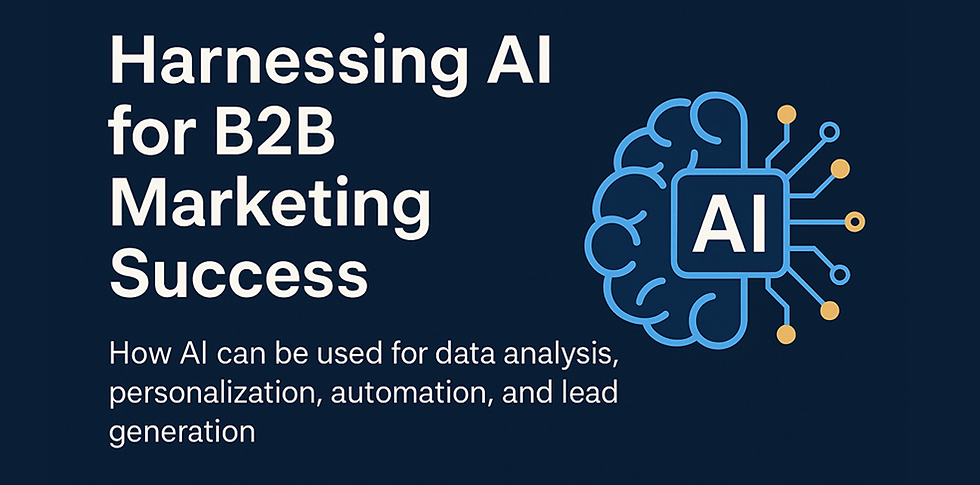Harnessing AI for B2B Marketing Success
- jocathell
- Aug 23
- 4 min read
Updated: Sep 8

B2B marketing is a balancing act: long sales cycles, multiple decision-makers, and the constant pressure to prove ROI. Add in endless emails, proposals, and campaign demands, and it’s no wonder marketers often feel stretched thin.
Enter Artificial Intelligence (AI)—not just a buzzword, but a practical toolkit that can help B2B marketers work smarter. From crunching mountains of data to personalizing outreach at scale, AI is transforming the way professional services firms connect with clients.
In this post, we’ll break down how AI is being used today, share practical examples, and show you where it can make the biggest difference in your marketing strategy.
What Does AI Really Mean for Marketers?
At its core, AI refers to machines simulating human intelligence—analyzing, predicting, and automating tasks. In B2B marketing, this means:
Data Analysis: Processing large volumes of data to uncover patterns humans might miss.
Personalization: Tailoring content, campaigns, and recommendations to specific audiences.
Automation: Handling routine tasks so teams can focus on strategy and creativity.
👉 When applied thoughtfully, these capabilities can reshape how firms attract, engage, and retain clients.
Let Data Do the Heavy Lifting
Data is the backbone of effective marketing—but raw numbers are only valuable if you can interpret them. AI excels here.
For example:
Website optimization: AI tools can map how users move through your site, flagging where prospects drop off so you can improve navigation.
Smarter segmentation: Instead of broad lists, AI can group clients by behavior—like identifying visitors who return to your antitrust page but never convert, so you can target them with tailored campaigns.
👉 This kind of analysis arms marketers with insights they can act on quickly, rather than spending weeks parsing reports.
Personalization at Scale
In B2B, personalization goes beyond “Hi [First Name].” Decision-makers expect content and outreach that speaks to their specific challenges.
AI makes this possible by:
Predictive analytics: Recommending solutions based on past behaviors. If a client regularly engages you for a specific service, AI can suggest complementary services.
Chatbots that know your clients: Modern bots don’t just answer FAQs—they engage, recommend, and route prospects to resources in real time.
👉 Done well, AI-driven personalization builds trust, shortens lead cycles, and strengthens client relationships.
Freeing Teams from Routine Tasks
Repetitive, manual work eats up hours better spent on strategy. AI can automate:
Email campaigns: Segmenting lists and sending personalized content at the right time.
Social media management: Scheduling posts, analyzing engagement, even drafting responses.
Proposal templates: Drafting first versions so teams only need to fine-tune.
👉 By letting AI handle the routine, marketing teams free themselves to focus on growth and innovation.
Smarter Lead Generation
AI can dramatically improve how businesses identify and nurture leads:
Lead scoring: Tools analyze behavior across web, email, and social to surface the most promising prospects.
Content recommendations: If someone downloads a whitepaper, AI can suggest related articles or case studies to keep them engaged.
👉 This means your business development teams can spend less time chasing unqualified leads and more time closing the right ones.
Case Study: Tech Solutions Inc.
Take the example of Tech Solutions Inc., a fictional project management software firm that was struggling with lead quality and conversions.
Data-Driven Insights
Using AI, they discovered most of their high-value leads came from IT and construction firms. They redirected campaigns to these sectors with the goal of increasing qualified leads.
Real-Time Engagement
An AI chatbot on their website answered client questions instantly and offered relevant product recommendations. Within three months, they planned to see website conversions jump significantly.
Email Automation
AI-driven email campaigns segmented audiences by behavior. Personalized sends have the potential to boost open and click-through rates.
👉 Lesson learned: By combining analysis, automation, and personalization, Tech Solutions Inc. had a plan to grow faster while reducing wasted effort.
Overcoming Common Challenges
AI adoption isn’t without hurdles. The biggest?
Data quality: AI is only as good as the data you feed it.
Integration: Aligning new tools with legacy systems can be tricky.
Cost: Upfront investment requires a clear ROI plan.
👉 The key is to start small, test solutions, and scale up as you prove value.
Quick Wins You Can Try Now
If you’re curious about AI but unsure where to begin, here are three easy entry points:
Pilot an AI-powered email tool to test personalization.
Add a chatbot to one service line or practice page.
Run a data-cleaning audit so you’re ready for predictive analytics.
Final Thoughts
AI isn’t here to replace B2B marketers—it’s here to free us from the routine work that clogs our calendars and give us back time for strategy, creativity, and client relationships.
The firms that thrive won’t just be the ones who adopt AI—they’ll be the ones who experiment, refine, and apply it thoughtfully to real business challenges.
So start small. Test, learn, and adapt. Because in the end, AI isn’t about keeping up with the competition. It’s about setting the pace.
👉 What about you? How are you weaving AI into your marketing? Share what’s worked (and what hasn’t) in the comments.



Comments